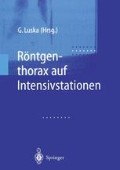Zusammenfassung
Lungenödeme zählen zu den häufigsten Befunden von Thoraxaufnahmen der Intensivstation und können pathogenetisch in vier Kategorien unterteilt werden (Gluecker et al. 1999):
-
Ödeme durch erhöhten hydrostatischen Druck
-
Ödeme durch erhöhte Kapillarpermeabilität mit diffusen Alveolarschäden
-
Ödeme durch erhöhte Kapillarpermeabilität ohne diffuse Alveolarschäden
-
Ödeme durch erhöhten hydrostatischen Druck und erhöhte Kapillarpermeabilität.
Access this chapter
Tax calculation will be finalised at checkout
Purchases are for personal use only
Preview
Unable to display preview. Download preview PDF.
Literatur zu Unterkapitel 7.5
Desai SR, Hansell DM (1997) Lung imaging in the adult respiratory distress syndrom: current practice and new insights. Intensive Care Med 23: 7–15
Gluecker T, Capasso P, Schnyder P et al. (1999) Clinical and radiologic features of pulmonary eodema. Radiographics 19: 1507–1531
Gudinchet F, Rodoni P, Sarraja A, Payot M, Schnyder P (1998) Pulmonary oedema associated with mitral regurgitation: prevalence of predominant right upper lobe involvement in children. Pediatr Radiol 28: 260–262
Manier G, Mora B, Casting Y, Guenard H (1984) Pulmonary oedema in pulmonary embolism. Bull Eur Physiopathol Respir 20: 55–60
McConkey PP (2000) Postobstructive pulmonary oedema — a case series and review. Anaesth Intensive Care 28: 72–76
Novak D (1988) Inhalationsschäden durch Gase. In: Frommhold W, Diehlmann W, Stender HS, Thurn P (Hrsg) Radiologische Diagnostik in Klinik und Praxis. Thieme, Stuttgart New York, S 729–743
Oelz O, Maggiorini M, Ritter M, Waber U, Jenni R, Vock P, Bartsch P (1989) Nifedipine for high altitude pulmonary oedema. Lancet 2(8674): 1241–1244
Villani F, Galimberti M, Rizzi M, Manzi R (1993) Pulmonary toxicity of recombinant interleukin-2 plus lymphokine-activated killer cell therapy. Eur Respir J 6: 828–833
Woodring JH (1997) Focal reexpansion pulmonary oedema after drainage of large pleural effusions: clinical evidence suggesting hypoxic injury to the lung as the cause of oedema. South Med J 90(12): 1176–1182
Editor information
Editors and Affiliations
Rights and permissions
Copyright information
© 2002 Springer-Verlag Berlin Heidelberg
About this chapter
Cite this chapter
Luska, G. (2002). Klinik und Radiodiagnostik der Lungenödeme. In: Luska, G. (eds) Röntgenthorax auf Intensivstationen. Springer, Berlin, Heidelberg. https://doi.org/10.1007/978-3-642-97901-9_14
Download citation
DOI: https://doi.org/10.1007/978-3-642-97901-9_14
Publisher Name: Springer, Berlin, Heidelberg
Print ISBN: 978-3-642-97902-6
Online ISBN: 978-3-642-97901-9
eBook Packages: Springer Book Archive

